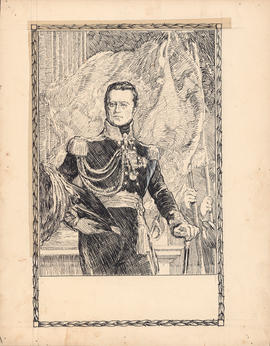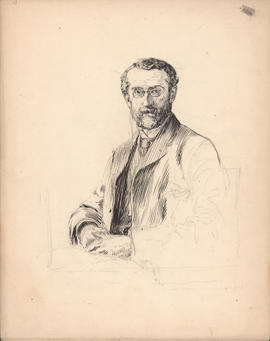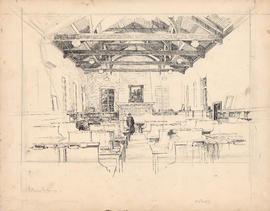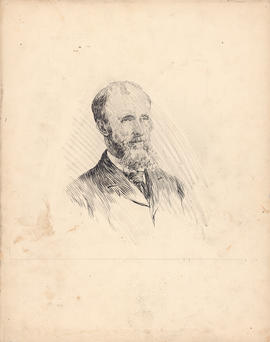Title and statement of responsibility area
Title proper
General material designation
- Graphic material
Parallel title
Other title information
Title statements of responsibility
Title notes
Level of description
Repository
Reference code
Edition area
Edition statement
Edition statement of responsibility
Class of material specific details area
Statement of scale (cartographic)
Statement of projection (cartographic)
Statement of coordinates (cartographic)
Statement of scale (architectural)
Issuing jurisdiction and denomination (philatelic)
Dates of creation area
Date(s)
Physical description area
Physical description
22 prints
Publisher's series area
Title proper of publisher's series
Parallel titles of publisher's series
Other title information of publisher's series
Statement of responsibility relating to publisher's series
Numbering within publisher's series
Note on publisher's series
Archival description area
Name of creator
Biographical history
Arthur Lismer was born 27 June 1885 in Sheffield, England. He was apprenticed to a photo-engraving company at the age of thirteen, and started evening classes at the Sheffield School of Arts at the same time. In 1905 he moved to Antwerp to continue his education at the Académie Royale des Beaux-Arts.
In 1911 Lismer immigrated to Toronto, where he was employed first at the commercial art firm Grip Limited, and later at Rous & Mann. It was during this period that he met fellow artists J.E.H. MacDonald, F.H. Johnston, Franklin Carmichael and Tom Thomson.
Lismer moved with his wife, Esther, and young daughter, Marjorie, to Nova Scotia in 1916, where for three years he served as principal of the Victoria School of Art and Design in Halifax. During this period he sketched and painted images of naval activity in and around Halifax Harbour, and in June 1918 was commissioned by the Canadian War Records, for which he produced a series of sixteen lithographs. He also created a number of drawings chronicling the aftermath of the Halifax Explosion, which were published in the Canadian Courier newspaper and in The drama of a city: the story of stricken Halifax (1918).
In 1919 Lismer was commissioned by the Dalhousie Centenary Committee to produce a series of sketches to illustrate the committee’s centennial commemoration publication, One hundred years of Dalhousie, 1818–1918 (1920), some of which were also reproduced in a promotional booklet published to advance the university’s 1920 "Millions Campaign” appeal.
Before the end of 1919 Lismer returned to Toronto to take up the post of vice-principal of the Ontario College of Art, and several years later became a charter member of the Group of Seven. In 1927 he was appointed supervisor of art education at the Art Gallery of Toronto and emerged as a leading figure in art education in Canada. From 1940–1967 he taught at the Art Association of Montreal.
Arthur Lismer died on 23 March 1969.
Custodial history
Scope and content
Collection includes 41 original pen and ink drawings by Arthur Lismer commissioned ca. 1919 by Dalhousie's Centenary Committee to illustrate its history of the university's first century: One Hundred Years of Dalhousie, 1818–1918, which was published in 1920. The collection includes the original and some unfinished and/or unpublished versions of all but one of the 26 illustrations used in the book, which features historic and contemporary Dalhousie figures and buildings. There are several portraits of President Arthur Stanley Mackenzie, which were rejected in favour of publishing a photographic image, as well as a rough sketch of Lismer's daughter, Marjorie. Also included in the collection are 22 reproductions, which are probably printer's proofs, given the poor quality of the paper.
Twelve of the Lismer images were also reproduced in the booklet titled simply Dalhousie University, which was produced by the Dalhousie Million Committee as part of the promotional literature supporting the university's 1920 Million Dollar Campaign and published shortly after the Centenary Committee's book.
There is little documentary evidence beyond these two publications regarding the precise date or other details of the Lismer commission; one of the drawings is marked "1 March 1920," and another "27 March 1920," on date-received stamps from the engraving department of Rous & Mann, the Toronto company that printed both publications. The existing archival correspondence between the university and the printer (UA-3, Box 621, Folder 6) is from the Million Committee file, and refers only peripherally to the Centenary Committee's book project. A letter dated 24 March 1920 from Rous & Mann advises that the cuts, or illustrations, proposed for use in the campaign booklet were "at present locked up for the printing of the other Book in course of preparation," while later correspondence indicates that the printing and delivery of the campaign booklet gained precedence over the commemorative history, and the first run of these booklets was shipped on 17 April. The history was printed shortly after that, although by 26 May it had already been reprinted, owing to the misspelling of George Stewart Campbell, whose middle name appears in the first printing as "Stuart." The existence of the misprinted copies is due to their purchase at a steep discount by the Million Committee, who wrote: "... if the price were attractive a way might be found to use them."
No correspondence or documents have been found in the Dalhousie University Archives regarding Lismer's actual commission: within the Million Committee's correspondence file exists a single telegram from President Mackenzie to Arthur Lismer, dated 3 April 1920, which expresses a need to rush the printing along with the instruction: "leave layout to your judgement," the sole reference to Lismer's role in either project.
Notes area
Physical condition
Immediate source of acquisition
Arrangement
Language of material
- English


![The Right Honourable George Ramsay. Ninth Earl of Dalhousie. Founder of Dalhousie College : [print]](/uploads/r/null/1/a/7/1a71f99b7791b7f51b4b261a253d92e41d6232999503c536c34c6f5f1f62dd3b/0000-091_1_1_001_142.jpg)

![The original Dalhousie College, 1820–1887. Situated on the Grand Parade : [print]](/uploads/r/null/9/5/0/9506266fc2165731cdbe4cfadf94cc3d8c408ec1404a873e2cda04530c036fcd/0000-091_1_2_001_142.jpg)
![The original Dalhousie College, 1820–1887. Situated on the Grand Parade : [drawing]](/uploads/r/null/a/1/f/a1f6089364b0992de01137c3cda1d5558075b9f404fb063b35ccb832f737cf4e/0000-091_1_2_002_142.jpg)
![Facsimile of the brass on the corner stone of the original Dalhousie College : [drawing]](/uploads/r/null/4/4/a/44a05e9bc54268192d0b65d560694e3d25847327c9cc9517598b9f8c99c06314/0000-091_1_3_001_142.jpg)
![Meet of the Tandem Club on the Grand Parade in front of the old college : [print]](/uploads/r/null/8/b/2/8b2044b9a038b0d3a3b876f23769979537f9c2643b1f2c617126ed8027197cb2/0000-091_1_4_001_142.jpg)
![Meet of the Tandem Club on the Grand Parade in front of the old college : [drawing]](/uploads/r/null/b/4/7/b47bd8f2a1fa673cee42bcdaedfbbc8cfc379eb2f30a30be600700887e8c4615/0000-091_1_4_002_142.jpg)
![Rev. Thomas McCulloch, D.D. First president, 1838–1843 : [print]](/uploads/r/null/5/a/b/5ab8d98c689ecd1ecac1734072ec95a1926ff1ad646274eadbb5d3cc1c457293/0000-091_1_5_001_142.jpg)
![Rev. Thomas McCulloch, D.D. First president, 1838–1843 : [drawing]](/uploads/r/null/3/7/7/37791105e1188a4a8be47dca8beefbc88825ac58a1665471195f91a9e3226a0d/0000-091_1_5_002_142.jpg)
![Rev. George Munro Grant, D.D. One of the Fathers of Reorganization in 1863 : [print]](/uploads/r/null/6/6/1/661fd52c83a8216999516c737e7f7854c156bf94e770347578ed1892cf731612/0000-091_1_6_001_142.jpg)
![Rev. George Munro Grant, D.D. One of the Fathers of Reorganization in 1863 : [drawing]](/uploads/r/null/a/3/e/a3e796b7ccc2a3caeb1160600bd1ee333e1db1d1c9c2ca2c7e3c3bb361c73483/0000-091_1_6_002_142.jpg)
![Rev. Allan Pallok, D.D. One of the Fathers of Reorganization in 1863 : [print]](/uploads/r/null/7/9/1/791a74fe42b5a3b2e4df0e3889f453ac65d55fcef90aafee30a3e62384cdda22/0000-091_1_7_001_142.jpg)
![Rev. Allan Pollok, D.D. One of the Fathers of Reorganization in 1863 : [drawing]](/uploads/r/null/0/0/c/00c5cf7414d821f2a78b86dbdd2be50f084287692e58ee243c75bac14c7ac018/0000-091_1_7_002_142.jpg)
![Rev. James Ross, D.D. Second president, 1863–1885 : [print]](/uploads/r/null/b/6/3/b636a6cfc7a45a1774c9c5512b0aa9aea56f999902da7a9ff6290a38934ba967/0000-091_1_8_001_142.jpg)
![Rev. James Ross, D.D. Second president, 1863–1885 : [drawing]](/uploads/r/null/e/4/1/e41859ee75efdf0623f63f0570d07a195f6d3b792423d5ffe95ee1c7dc5bc590/0000-091_1_8_002_142.jpg)
![Charles Macdonald, M.A. Professor of mathematics, 1863–1901 : [print]](/uploads/r/null/6/9/b/69b3946286a4365e2fb49ec8876d6d2f2fd0b145859c4274883a1c04711aad9b/0000-091_1_9_001_142.jpg)
![John Johnson, LL.D. Professor of classics, 1863–1894 : [print]](/uploads/r/null/d/3/9/d390d8372a4f7d803c87655e66659632682f221514c240348d9480638fb9bb0c/0000-091_1_10_001_142.jpg)
![John Johnson, LL.D. Professor of classics, 1863–1894 : [drawing]](/uploads/r/null/e/e/b/eeb386f8f95da668af1d6aa06cf19e205c202683173fcb95ee7b04f80dea9d4b/0000-091_1_10_002_142.jpg)
![James DeMille, M.A. Professor of English, 1865–1880 : [print]](/uploads/r/null/e/d/1/ed147c85f79e09edad5444b52da869b9b482221a6c3afff46f06f3a2ef8db0d1/0000-091_1_11_001_142.jpg)
![James DeMille, M.A. Professor of English, 1865–1880 : [drawing]](/uploads/r/null/2/f/c/2fc4a961a561f961279d8f40faa0d95e8d111ea0ab7bd5b8d5db22edb7e236fc/0000-091_1_11_002_142.jpg)
![George Lawson, F.R.S.C. Professor of chemistry, 1863–1895 : [print]](/uploads/r/null/7/a/6/7a6bc70f4531d066c7abab4fcb7c9608062093a3e87e1333b59ff34a20470962/0000-091_1_12_001_142.jpg)
![Rev. John Forrest, D.D. Third president, 1885–1911 : [print]](/uploads/r/null/c/0/7/c0780c387beabfc298b41b6edec16f35ebc0471ff581986361b6bcde09e094eb/0000-091_1_13_001_142.jpg)
![Rev. John Forrest, D.D. Third president, 1885–1911 : [drawing]](/uploads/r/dalhousie-university-archives/f/f/3/ff3263822dcf09f8bb20b921a41b9b4203ad58255541848e6b1c67f760633f4f/0000-091_1_13_002_142.jpg)
![George Munro. The great benfactor of Dalhousie : [drawing]](/uploads/r/dalhousie-university-archives/7/3/f/73fdd68322e8b322af6f40c66bbe29576be5d7c7aa320468505c0d450c8655b5/0000-091_1_14_001_142.jpg)
![James Gordon MacGregor, F.R.S. Professor of physics, 1879–1901 : [print]](/uploads/r/dalhousie-university-archives/7/e/4/7e469f48f66e458644cd284616879709b1e6c3e6b19facdc78227ee761be7220/0000-091_1_15_001_142.jpg)
![James Gordon MacGregor, F.R.S. Professor of physics, 1879–1901 : [drawing]](/uploads/r/dalhousie-university-archives/c/5/1/c5109a72798dee2d84886ac03b30f335b17dce96d9ea5271b58d27546fe368af/0000-091_1_15_002_142.jpg)

![Richard Chapman Weldon, LL.D. Dean of the Law School, 1883–1914 : [print]](/uploads/r/dalhousie-university-archives/5/b/a/5ba47db0116dafac599bc8893fe17a58b40ad5b0e0fc6282dd9c303271b86eca/0000-091_1_16_001_142.jpg)
![Richard Chapman Weldon, LL.D. Dean of the Law School, 1883–1914 : [drawing]](/uploads/r/dalhousie-university-archives/c/1/8/c1886af387a8d21928c9ebb493193794eb016e9bb5c14df46752b8df46dad14e/0000-091_1_16_002_142.jpg)
![Sir William Young, Kt. Chairman of the Board of Governors, 1848–1885 : [print]](/uploads/r/dalhousie-university-archives/d/1/6/d1608e79b9f89fa4fea50fc8b8a1884ba57ec38fb8b9d6fe0164f531fc7afdbf/0000-091_1_17_001_142.jpg)
![Sir William Young, Kt. Chairman of the Board of Governors, 1848–1885 : [drawing]](/uploads/r/dalhousie-university-archives/6/3/1/6315532a260dbbb5298dbb3ab4f325b3f1a168c38c9f9b87f95423c89880260d/0000-091_1_17_002_142.jpg)
![Forrest Building. The second Dalhousie. Erected 1887 : [print]](/uploads/r/dalhousie-university-archives/1/6/5/165163e8ccc5a47aaefc4d450b18660c5f69ab199ebb33b7b226d418a677a718/0000-091_1_18_001_142.jpg)
![Forrest Building. The second Dalhousie. Erected 1887 : [drawing]](/uploads/r/dalhousie-university-archives/f/0/0/f001cf3121ea7e25ac7263010fff06ad2e0abb4915e6a3e46d1cdf3af1ff818d/0000-091_1_18_002_142.jpg)
![The Science Building. The first building erected at Studley, 1912 : [print]](/uploads/r/dalhousie-university-archives/d/4/c/d4c7521fd1b93c22d218979c044859eecb35d51564953aaa6d8868ff5f2302cb/0000-091_1_19_001_142.jpg)
![The Science Building. The first building erected at Studley, 1912 : [drawing]](/uploads/r/dalhousie-university-archives/9/3/7/937a28e5e45a7c092e41a4f64b3068992561b1e105f22eab693d7fe9afa560b8/0000-091_1_19_002_142.jpg)
![The Macdonald Memorial Library. Erected at Studley, 1914 : [print]](/uploads/r/dalhousie-university-archives/7/6/1/761bcb5860c4aa91878688de734f04d06dcaf3b012683d4bf18fbff23ff80213/0000-091_1_20_001_142.jpg)
![The Macdonald Memorial Library. Erected at Studley, 1914 : [drawing]](/uploads/r/dalhousie-university-archives/e/b/1/eb175e64283049e6ed002017a6919d4a5d365cc92562d921a3c6790f81c828de/0000-091_1_20_002_142.jpg)
![The portico of the Macdonald Memorial Library : [drawing]](/uploads/r/dalhousie-university-archives/b/d/c/bdc5f4a1aa4b2150a57c3c290a03b438074ef7c772f6cca9e59a030b32e5a9ed/0000-091_1_20_003_142.jpg)
![The main reading room of the Macdonald Memorial Library : [print]](/uploads/r/dalhousie-university-archives/2/6/2/262b3d8b8619ff2a067ada44e9fda093a63cd500613b5e9221dd82c1d94b8446/0000-091_1_20_004_142.jpg)
![Fireplace in the main reading room of the Macdonald Memorial Library : [print]](/uploads/r/dalhousie-university-archives/c/e/4/ce4aa8a8104d3bb7948623bb642978ded566251aefedebb1bdbc90abc17f7a0f/0000-091_1_20_006_142.jpg)
![George Lawson, F.R.S.C. Professor of chemistry, 1863–1895 : [drawing]](/uploads/r/null/4/8/5/485492191b10e42e7629cc6e696c50a8e5955b383cd892fbd34a736284a6f872/0000-091_1_12_002a_142.jpg)
![Unfinished Arthur Lismer sketch of George Lawson : [drawing]](/uploads/r/null/7/8/8/78825947c16fd1eea9d63d8601bfdd5a68433c181b99e914abf57c37a2c2df03/0000-091_1_12_002b_142.jpg)
![Charles Macdonald, M.A. Professor of mathematics, 1863–1901 : [drawing]](/uploads/r/null/4/0/f/40f5fd82fe6a73864fac19401d525e3abf5b3049f159c8340ffbf405902cd586/0000-091_1_9_002a_142.jpg)
![Unfinished Arthur Lismer portrait of Charles Macdonald : [drawing]](/uploads/r/null/2/4/9/249e8d07e940ae29ff08d9f3e8f21462ff268d561110d420671de3e2b29802bd/0000-091_1_9_002b_142.jpg)
![The main reading room of the Macdonald Memorial Library : [drawing]](/uploads/r/dalhousie-university-archives/5/3/8/5382edfd4580980b450e14d424f38e1f0bc9af76e40ffebf07dd1f28e63bc1f2/0000-091_1_20_005a_142.jpg)

![Fireplace in the main reading room of the Macdonald Memorial Library : [drawing]](/uploads/r/dalhousie-university-archives/9/9/b/99b3ca3a9e35f3d65a1b396118e4497ff22860df4e852c36a3a18c87e7cc31ca/0000-091_1_20_007a_142.jpg)

![Andrew Walker Herdman Lindsay M.D. Secretary of the Faculty of Medicine, 1885–1915 : [print]](/uploads/r/dalhousie-university-archives/1/b/3/1b30c81e1cf29fee83ce41caeab704946107129872f312e3b5d5550a50c4581a/0000-091_1_21_001_142.jpg)
![Andrew Walker Herdman Lindsay, M.D. Secretary of the Faculty of Medicine, 1885–1915 : [drawing]](/uploads/r/dalhousie-university-archives/f/7/e/f7e762064473ed45a6894e038673f7c8b5599c0dd3ad371cca44de72688b9d50/0000-091_1_21_002a_142.jpg)